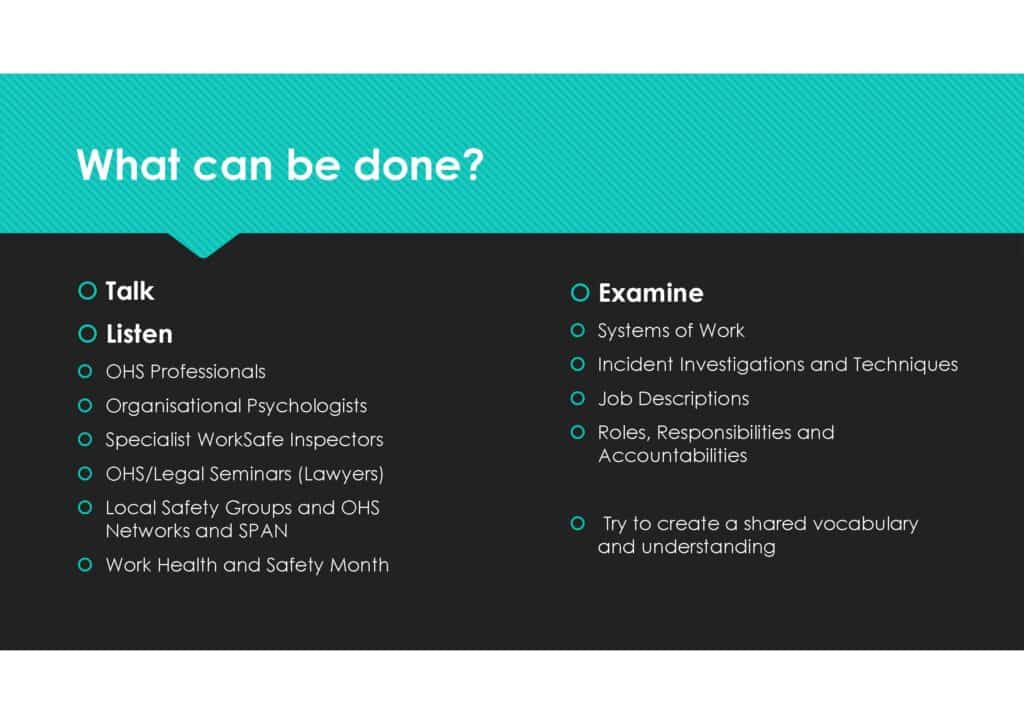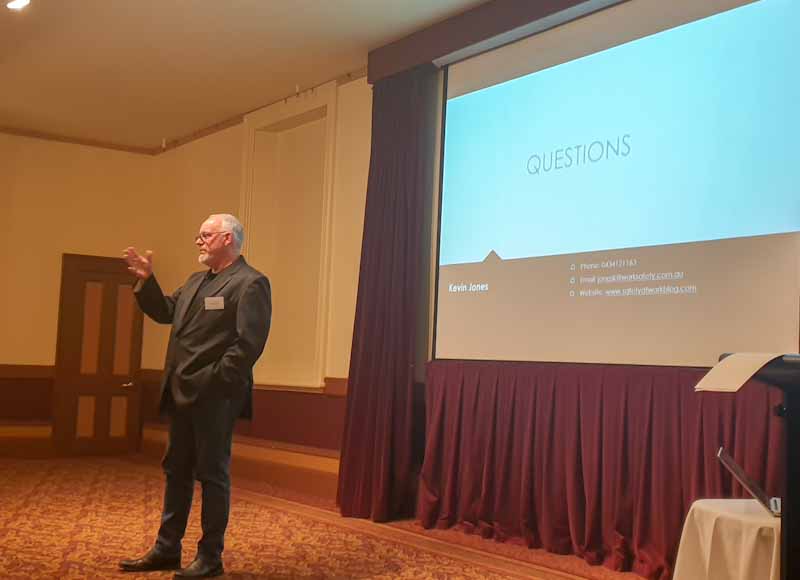Seminars on workplace mental health must always offer solutions and not only (always) the solution that the host wants to promote. Occupational health and safety (OHS) needs to be more altruistic (Yes, it may be hypocrisy from a subscription blog). Recently I spoke on the issue of psychosocial hazards at work and offered this slide on “What can be done?” [Note: This article discusses suicide]

There are many mental health advocates who are offering risk assessment products and templates supported by expertise. It is possible to outsource these assessments (often for a hefty price), but one cannot outsource one’s OHS responsibilities or duties of care. As a result, the most cost-effective control of psychosocial hazards is to think for one’s self. Employers have a lot of knowledge on this matter but are often unaware. A best guess, a gut feeling, or the “vibe” is a good place to start. If something doesn’t feel right, it usually isn’t. But once you have that unease, where do you go? What’s the next step?
Talking
Talking is the first step, and this may need bravery to break a culture of silence or the stigma surrounding mental stress and anxiety. It is always worth starting with a personal story on one’s own stresses and anxieties, the impacts on home and family life or suicides of relatives or others, of the loss of lives before they really started, IF you feel up to it. None of this is obligatory. Do not feel that you must revisit traumatic events. I started my recent presentation by reminding people of the tragedy of Brodie Panlock.
Listening
Listening is the next. If you have yet to be trained in the skills of active listening, take a course. It is hard to shut up and listen because we all feel our stories are important to others, and we want to tell them. Active listening teaches you to wait for someone else to talk, to fill the conversational gaps of silence and to open more than in normal conversation. It is frequently used by journalists because it works. But that is listening to another or a troubled colleague or a relative, a skill that organisations like Mates in Construction promote. Sure, ask the question about their mental health state, but wait for the response and listen carefully to what is said and how it is said.
The other part of Listening is determining who to listen to for advice. The image above offers this list in no particular order:
- OHS Professionals
- Organisational Psychologists
- Specialist WorkSafe Inspectors
- OHS/Legal Seminars (Lawyers)
- Local Safety Groups and OHS Networks, and SPAN (Suicide Prevention Awareness Network or your local equivalent)
- Work Health and Safety Month seminars
Each category offers a slightly different approach and costs, but some offer free, or pro bono, advice. There may be some enlightened Human Resources professionals who offer mental health advice that is compatible with Australia’s psychosocial regulations and international standards, but currently, they are rare.
Examine
Many people start by trying to determine a mental health risk profile for their company. This is possible but often seems to stall when the magnitude of the tasks or the lack of usable data is realised. This is part of the reason I suggest starting with Talking and Listening. A lot of information and data are accessible through conversation, and conversation can direct you to more useful sources. It is important to understand that the assessment of psychosocial risk is likely to be far more subjective and qualitative than other occupational hazards and risks.
Useful information sources include
- Systems of Work
- Incident Investigations and Techniques
- Job Descriptions
- Roles, Responsibilities and Accountabilities
These are sources of information that are readily accessible but should also be targeted for change. Perhaps the most significant of this list is Roles & Responsibilities. Of all the investigations of OHS management systems, these have been poorly designed and/or maintained, and many workers only consider them for a job interview. These elements are defined most commonly in Job Descriptions, which are critical documents for how we manage OHS and enforce or comply with our working conditions.
Regarding incident investigations, psychosocial hazards such as mental health or stress or fatigue are rarely considered unless they are directly relevant to an incident like sexual harassment or bullying, for instance, but they are almost always one of the contributing factors in some form or another. Past incident reports are unlikely to include mental health as a factor largely because mental health is almost never included as a consideration in investigation processes or in the pulldown lists applied by many incident investigation systems. Our systems are built to exclude psychosocial factors, and then we fret about the inaccessibility of data and information?! Perhaps we should be asking whose interests these exclusions served.
The presentation slide above is only one of the slides I used in my 90-minute presentation to the Bendigo Regional HR Network (featured image above). There are a couple more articles to come based on this presentation….. for subscribers only.
If this article has raised issues that you would like to discuss with a support person, in Australia, contact Lifeline on 13 11 14 or through the website.


Thanks for sharing!